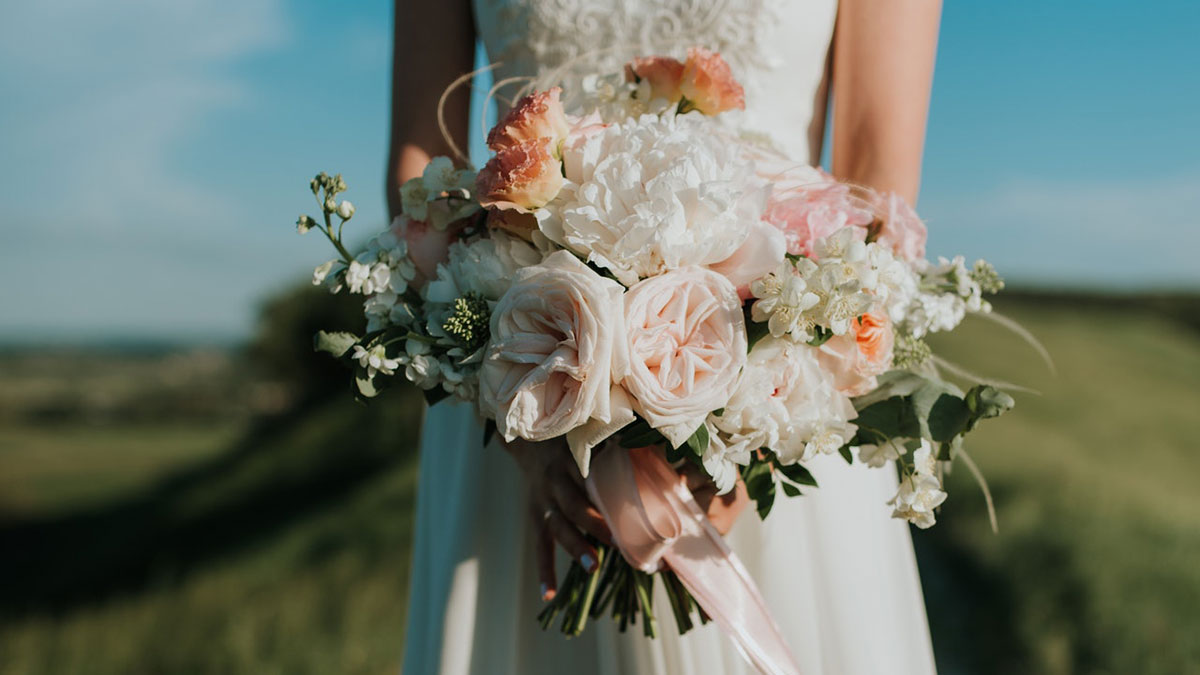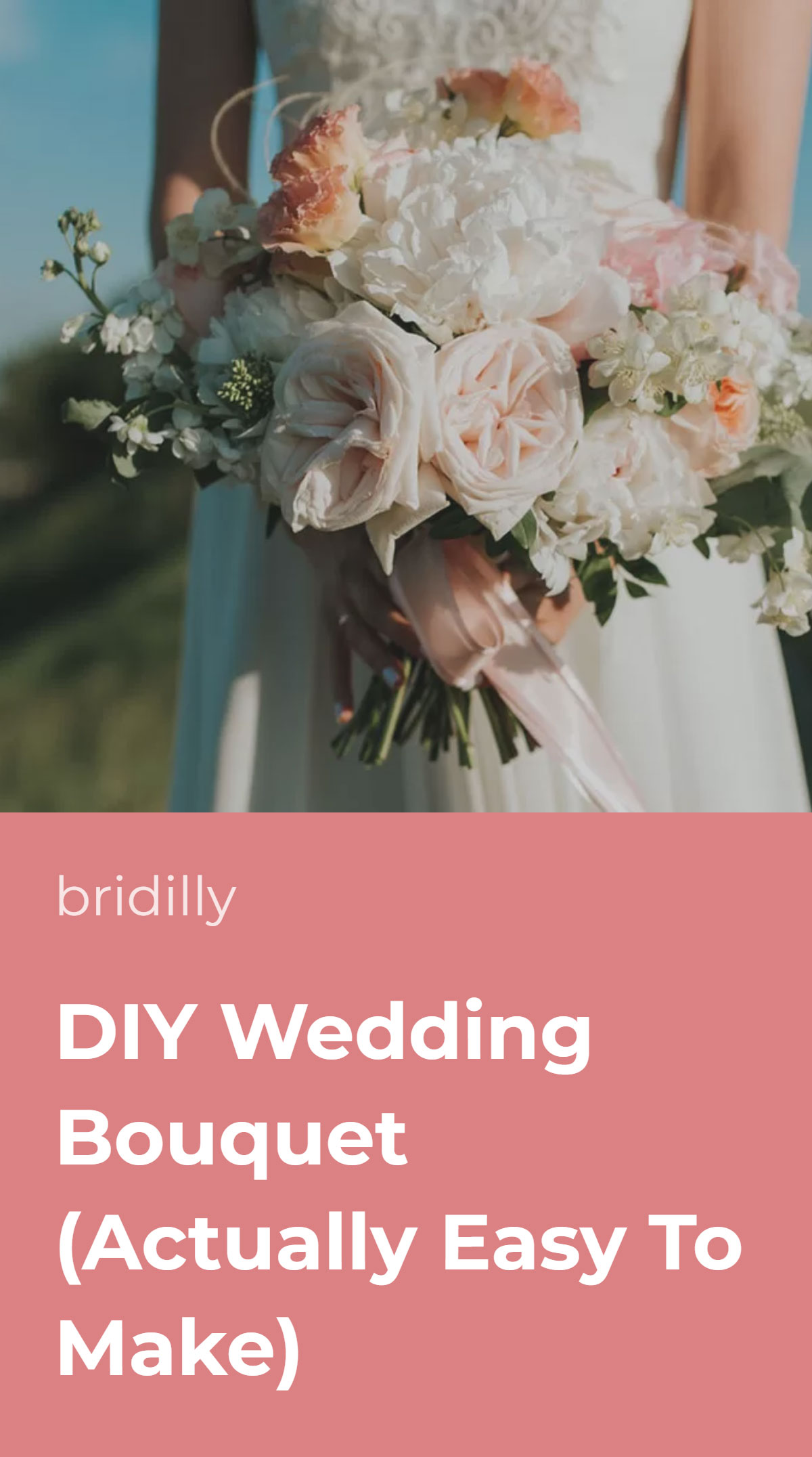Bridal flower arrangements are crazy expensive (for a reason, and still). That’s why many brides opt for a DIY wedding bouquet.
A DIY bridal bouquet is not only a way to save some money but also to showcase your creativity and skill.
The first thing you should consider is the wedding bouquet design. It should match your style and personality. However, don’t go overboard.
A cascading bouquet from orchids and peonies adorned with pearls may be pretty. But it may also be too complicated to bring to life if you don’t have experience.
Arranging a bouquet on your own is easier than preparing dinner for 150 guests, but the process shouldn’t be taken lightly.
Following professional tips when picking and assembling the blooms is crucial for a long-lasting, beautiful bouquet.
Table of Contents [show]
Determine Your Style
Weddings always demand planning, and your bridal bouquet is no exception. You can’t simply come to the store, pick random flowers, and tie them together. Well, technically, you can, but should you?
Your wedding bouquet is an important element of your attire and the overall wedding theme.
Consider your style, dress, and interior colors when creating the wedding bouquet design. Yes, that’s right – you should draw your wedding bouquet design concept before starting to gather supplies.
For example, if you have a wedding in rustic style, choose a bouquet from wildflowers. If you have a tropical wedding, go for a bouquet of bright, exotic florals.
Bridal bouquet styles differ not only in terms of the florals used but also in terms of arrangement types. For instance, a small nosegay bouquet will match the humblest brides who prefer minimalism.
On the opposite, if you admire everything extravagant, opt for a large crescent, cascading, or asymmetrical wedding bouquet.
The season is another point to consider when deciding on your DIY wedding bouquet look.
Traditionally autumn flowers such as yellow chrysanthemum or fountain grass may look odd in spring, even if they are your favorites. Furthermore, seasonal flowers are usually cheaper.
How to Select Flowers
When I say “select flowers,” I don’t mean “pick the flower type.” This should be already decided on in the first step.
Now, it’s time to choose the freshest blooms available at your local florist, and it isn’t always as simple as it seems.
Of course, the most apparent way to determine the condition of a flower is to look at it.
Don’t buy blooms with faded, transparent, wilting petals. However, florists may use multiple tricks to make the florals look brighter.
One tip is to feel the undersides of the petals. Fresh blooms have firm petals. If you hear faint rustling when sliding your fingers from the stem to the petal ends, the blooms are healthy and full of life.
Study the blooms for any seeds or pollen. They indicate that the flower was already past its prime when it was cut, so it won’t stay for long. Then, inspect the stems – they should be lively, strong, and clean.
The last tip is to pick flowers with closed or starting to open buds instead of ones that are already open. This will ensure a longer lifespan of your bouquet.
“How many flowers do I need for my wedding bouquet,” you may wonder? Well, this depends on the desired size of the bouquet and the chosen flower type. For reference, an eight-inch rose bouquet requires 30-60 blooms.
Bear in mind that some flowers are easier to work with than others. So, tulips and ranunculus break easily and wilt faster, whereas roses or carnations have strong stems and thus are longer-lasting.
Gather Supplies
Florals aren’t the only thing you need for a DIY wedding bouquet.
You will need a bucket for flower preparation, some paper towels, waxed floral tape or rubber bands, a stem stripper, straight pins, a sharp knife, and a ribbon of your choice.
The list is quite straightforward, but some points are worth noting. If you’re going for a large bouquet and have many flowers, get multiple buckets – the flowers shouldn’t be crowded.
Don’t use regular scissors to cut the stems, as you may crush them and prevent water from properly getting inside the flower. This may reduce the lifespan of your bouquet, so choose professional floral scissors or knives.
If your bouquet includes roses, don’t forget to strip the thorns. No bride wants to hurt her hands while walking down the aisle.
Regular tape won’t do the job either, as it won’t stick to wet stems. That’s why you need floral tape. Floral adhesive, in turn, is necessary to hold together small arrangement elements.
Lastly, choose a wide ribbon that suits your wedding dress or accessory color. A narrow ribbon may hold the flowers together but will look a bit messy.
Use a special finishing spray to lock in the moisture and give flowers a nice sheen.
Flower Preparation
Before assembling your bouquet, you should prepare the blooms, and this should be done properly to ensure a long lifespan and fresh look of your bouquet.
The first step is stripping the stems. Use a stem stripper to gently remove thorns and excess leaves.
Then, place the flowers in a bucket with clean water and use a stem cutter or sharp knife to cut the stems. Do this while holding the stems underwater and cut at an angle about two inches from the bottom.
Leave the freshly cut flowers in a bucket for a minute, then place them in a different bucket with colder water. Ensure the water isn’t warm, as this will force the blooms to open and shorten their lifespan.
That’s it – you can move on to assembling the bouquet. Keep the stems long while you’re doing this, and adjust the length once the bouquet is complete.
Bouquet Assembling
Wedding bouquet assembling is the trickiest part, even if it seems simple. Start with the center blooms.
Take one flower at a time and assemble four center flowers at an even height. Constantly keep the center construction with one hand.
Then, start adding other flowers one by one around the center flowers, creating the desired shape.
The most common wedding bouquet shape is a dome, but you can create a crescent, asymmetrical, cascade, or heart-shaped wedding bouquet if you’re sure in your skill.
Tip – assemble your bouquet while standing in front of a mirror. This way, you will see how it looks in your hands and can adjust the arrangement before it gets too late.
Once the bouquet acquires the necessary shape and all flowers are in, it’s time to secure your arrangement.
First, bind the stems with a rubber band or floral tape to hold the florals together at the point where they naturally join.
Bind the stems once again closer to the end. Leave excess stem length untouched. If the wedding isn’t close yet, place the bouquet in water and continue with finishing the handle right before the event.
If the special day is already here, cut the excess stems using a stem cutter or a sharp knife, making sure they’re all the same length.
Dry any remaining water with a paper towel and tuck one end of a ribbon inside the upper stem bind.
Wrap the stems with the ribbon, spiraling it down without leaving any gaps. After reaching the bottom, use a small straight pin to secure the ribbon and spiral it back up. Tuck the second end underneath the upper bind again.
Finishing Touches
The next steps aren’t mandatory, but they can make your bouquet look truly exquisite and last longer.
So, after finishing the handle, you may cut another piece of ribbon and tie it around the stems in a bow. Leave the ends of the bow hanging.
Spray the flowers with a dedicated solution to give them a delicate sheen and preserve the moisture – it can be found in florist stores. You may also use a sparling spray for a more celebratory look.
If you’d like to add some bling, such as pearls on a wire or brooch, you can do this both while assembling the bouquet or as a finishing touch. This merely depends on the element mounting type.
The best time to make a DIY wedding bouquet is in the morning before the event.
However, if you’ve made it earlier, not to worry – wrap it in tissue, put it in water, and place it in the refrigerator. Take it out right before the event.
Some Ideas
Making a DIY bridal bouquet is a large responsibility, as you won’t have a chance to fix it if something goes wrong. Thus, it’s best to opt for relatively simple arrangements with easy-to-care flowers.
To ensure your bouquet is made from the freshest, prettiest blooms, choose seasonal flowers.
The easiest cut flowers to care for are roses, amaranth, hydrangeas, and lilies. Cut flowers with a shorter lifespan include sunflowers, gladiolus, and dahlias.
If you’re worried your bouquet won’t last until the wedding, consider creating one from pearls instead. A DIY pearl bridal bouquet will certainly draw attention and look astonishing in pictures.
Make sure not to throw such a bouquet to your bridesmaids – it may be heavy! Instead, you can leave it after the wedding as interior décor.













No Comments Add one
Leave a Comment